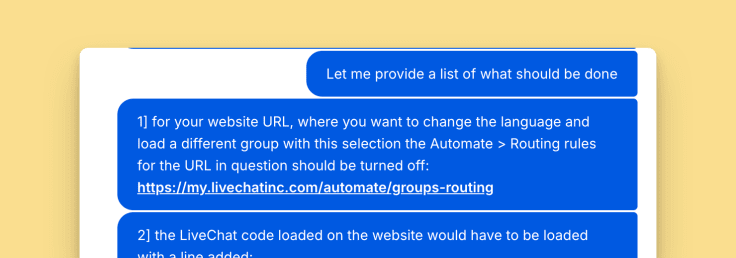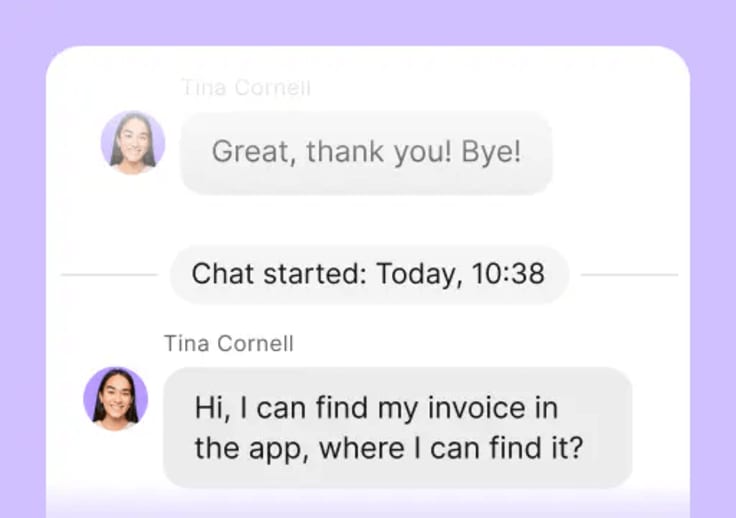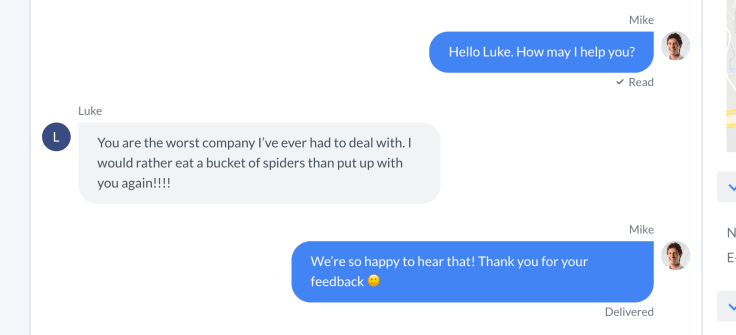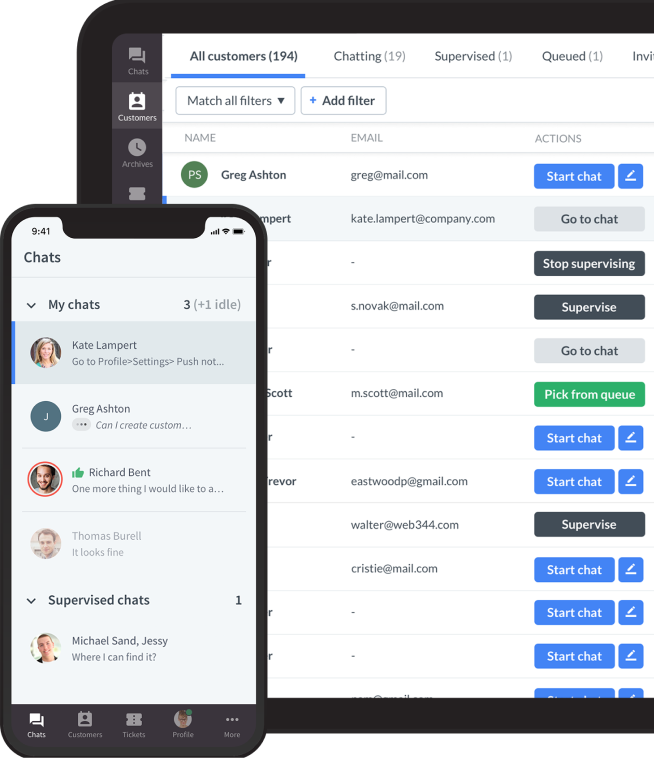
Fast service matters, but fast and friendly is what keeps customers coming back. Live chat combines the speed of digital communication with the human touch of real-time interaction. But without proper love chat etiquette, even quick replies can come off as cold or dismissive.
As customer service expert Shep Hyken puts it, “A customer service experience can change the entire perception a customer has of the organization.” That perception hinges not just on solving problems, but on how those problems are addressed.
That’s why live chat etiquette is essential. When agents use clear language, maintain a professional tone, and show genuine empathy, conversations become more productive and resolutions happen faster.
This guide unpacks the core etiquette practices that elevate your live chat support strategy — reducing friction, increasing resolution speed, and turning service moments into customer loyalty.
Pre-live chat etiquette rules
Before a live chat begins, explain what the customer can expect from the interaction. This might include the average wait time, the type of support available through chat (technical, billing, general inquiries), or the hours when customer service agents are live.
Setting boundaries and expectations upfront not only prevents frustration but also empowers the customer to choose the best support path for their needs. A pre-chat message like, “Hi there! You’re number 2 in the queue. An agent will be with you shortly,” can be more calming than silence.
Use professional visuals
Customers feel more confident when they know who they’re talking to. Displaying a live chat agent’s name and a professional profile photo (or a brand avatar that reflects your tone) reassures customers that a real, qualified person is behind the screen. Avoid blank or default images — this small touch adds a layer of authenticity and professionalism that builds credibility in an instant. Enhancing this with eye-catching graphics can further improve engagement.
Understand the issue upfront
Gathering context before diving into the conversation is key to resolving issues faster and more efficiently. Pre-chat forms that ask for basic information, like the customer’s name, order number, or reason for reaching out, help live chat agents start with clarity. It also prevents the customer from having to repeat themselves later. Even if you don’t use a formal form, a thoughtful first question like, “Can you tell me a bit more about what’s going on so I can help right away?” shows initiative and attentiveness.
Show availability, not urgency
Being present and responsive is crucial, but so is pacing. Avoid the urge to interrupt or send multiple rapid-fire messages while the customer is typing. Instead, let them share their issue fully before responding. This signals that you’re listening, not just reacting. Creating space for the customers to express themselves builds trust and helps prevent misunderstandings that come from assumptions or rushed replies.
Focus on tone, transparency, and honesty
How you say something in live chat often matters more than what you say. Customers may forget the exact words you use, but they’ll always remember how you made them feel. That’s why the tone of your live chat interactions plays a critical role in shaping customer perceptions. Combine that with honesty and clear communication, and you’ve got the foundation for a strong, trustworthy customer relationship.
Live chat doesn’t need to sound like a formal email or a technical document. Customers prefer a conversational, positive tone — something warm, natural, and easy to follow. Instead of saying, “Your request has been processed,” try “Great news! I’ve taken care of that for you.” That kind of phrasing, rooted in good live chat etiquette, makes communication feel human and helpful rather than cold or mechanical.
Even when resolving complex issues, positivity in your language helps customers feel reassured and supported. Just be sure to adapt your tone to match the customer’s energy. If they’re formal and concise, don’t be overly casual in return.

If you don’t have the answer right away, say so, then let the customer know what steps you’ll take to find it. Customers appreciate honesty far more than deflection or vague promises. For instance, “I’m not 100% sure, but I’ll double-check with our billing team and get back to you in just a moment,” builds more trust than pretending to know and stalling.
Transparency is especially important when there’s a delay, a policy limitation, or a service issue. Letting the customer know what’s happening and why goes a long way in diffusing frustration.
Lastly, mistakes happen, and even when they’re not your fault, customers want acknowledgment. A sincere, human apology can calm tensions and rebuild trust quickly. Avoid scripted phrases like “We apologize for the inconvenience.” Instead, use something more genuine and empathetic: “I’m really sorry for the trouble this caused you, let’s work together to make it right.”
Respond quickly and clearly
Customers expect quick responses in chat, often within seconds. In fact, industry data shows that the average expected response time is under one minute. Falling short of that can lead to impatience, repeat inquiries, or worse, chat abandonment. Customer service chat etiquette starts with responsiveness — even a quick acknowledgment can keep customers engaged and confident that help is on the way.
Even if you don’t have a full answer yet, send a quick message like “Let me check that for you; it’ll just take a moment” to let the customer know you’re present and actively working on their live chat request. A few seconds of acknowledgment can prevent a lot of uncertainty.
Long-winded explanations can overwhelm anyone in a chat window. Aim to keep your messages short, structured, and informative. Break things up into digestible chunks instead of sending a long paragraph.
For example, rather than saying, “I apologize for the issue you’re experiencing, and I will now proceed to investigate the root cause of the problem and report back once I’ve gathered more information,” simply say, “I’m checking into this for you, thanks for your patience!” Clear, simple phrasing helps customers absorb information quickly and accurately.
Unless you’re speaking to a highly technical audience, avoid using specialized technical terms or acronyms that might confuse your customer. Instead of saying, “The issue stems from a backend API timeout,” reframe it as “It looks like there’s a short delay on our system’s side. We’re working on it, and it should be resolved soon.” The goal is to explain things in a way anyone can understand without sounding dismissive or condescending.
Some live chat platforms allow for line breaks, numbered lists, or bolding key terms. Use these sparingly but strategically to improve clarity. For example, if you're walking a customer through multiple steps, present them as a list rather than a wall of text. This makes it easier for the customer to follow along and reduces the chance of missteps.
Build trust through exceptional customer service
One of the fastest ways to lose trust is to overpromise and underdeliver. If you say you’ll email an update, send a refund, or escalate an issue, do it — and do it within the timeframe you’ve set. Customers remember whether promises were kept, and reliability plays a major role in whether they’ll return. If there’s a delay or change, proactively update the customer before they have to chase you. Following professional chat etiquette means being accountable, consistent, and clear in every customer interaction.
Positive phrasing not only sounds better, it feels better. Instead of saying, “I can’t process that request right now,” try, “What I can do right now is escalate this to a supervisor for a faster resolution.” These subtle shifts keep the live chat conversation focused on solutions, not roadblocks. The more you can affirm the customer’s concerns while offering a clear path forward, the more empowered they’ll feel.
Whether it’s a system outage, shipping delay, or internal miscommunication, transparency is key. Avoid vague live chat responses like “We’re looking into it.” Instead, give specific, honest updates: “We’re currently experiencing an issue with our payment system—our engineers are working on it, and we expect to have it resolved within the hour.”

Moreover, customers are more likely to accept a policy or process if they understand the reasoning behind it. If a refund can’t be processed after a certain period, don’t just state the rule — explain the rationale. For example, “Our system is set to process refunds within 30 days to ensure accurate billing cycles and prevent processing errors.” Providing this kind of context reflects a deeper level of care and professionalism — key components of live chat etiquette tips.
Lastly, remember: trust isn’t a one-time event; it’s a relationship. End chats with an open invitation to return: “If anything else comes up, just reach out. We’re always here to help.” Leaving the door open like this makes customers feel like they’re being cared for beyond the current chat, encouraging them to stay loyal to your brand.
Use proactive chat support techniques
Many live chat platforms allow support teams to see what the customer is typing before they hit send, an option known as live typing preview. When used respectfully, this can help live chat agents prepare accurate, timely responses. If a customer is typing out a long issue, you can begin gathering necessary resources or pulling up their account, so by the time they hit “send,” you're already ready to help. Live chat etiquette rules emphasize using this feature to assist, not rush, the conversation.
Just be sure not to interrupt them mid-message. Wait for them to finish before responding to avoid seeming intrusive.
At the same time, don’t wait for customers to get stuck; reach out first. Use proactive chat triggers based on user behavior, such as lingering on a pricing page, repeated visits to a help article, or stalled checkout activity. A well-timed “Hey there! Need help deciding which plan is right for you?” can dramatically increase conversions and prevent support issues from escalating.

Sometimes customers ask one thing but really need help with something deeper. A question like “Where do I find my invoice?” might actually be about confusion over billing. Train customer support agents to gently dig deeper and offer additional context. For example, “You can find your invoice under Account > Billing. Are you checking that for a specific charge or refund?” This shows initiative, empathy, and adherence to live chat etiquette tips that prioritize full resolution over rushed replies.
Proactive support isn’t just about starting live chat conversations, it’s about seeing where the conversation is going. If you know a common follow-up question usually comes next, answer it upfront. “I’ve just processed the return. You’ll receive a confirmation email shortly, and the refund should appear in your account within 3–5 business days.” This prevents unnecessary back-and-forth and demonstrates thoughtfulness.
Use tools and canned responses efficiently
Canned responses are fantastic for answering frequently asked questions, reducing typing time, and keeping answers accurate, but they should never be copy-pasted word-for-word without context. Live chat etiquette calls for a personal touch, not just speed.
Live chat agents should always personalize these replies by adding the customer’s name, tweaking the wording to match the conversation tone, or briefly referencing the customer’s specific issue. This extra 10 seconds makes a huge difference in how the message is received.
Example:
Instead of sending:
“Your order has shipped. You’ll receive it in 3–5 business days.”
Try:
“Thanks for your patience, Alex—your order is on its way! You should receive it within 3–5 business days, and I’ve just emailed the tracking link.”
Additionally, keyboard shortcuts and macros can help customer service agents move faster through routine interactions, such as friendly greetings to customers, collecting information, or confirming resolutions. But they should serve as support, not a replacement, for active listening and custom responses. Tools should speed up the basics, so live chat agents have more time to focus on what matters: understanding and solving the customer’s problem.

Live chat tools often include file sharing, screen recording, or even co-browsing features. When appropriate, use them to provide more engaging and visual help. For example, rather than describing steps in a long message, share a screenshot or quick video walkthrough. It reduces confusion and helps visual learners resolve issues faster.
Lastly, don’t let your tools run on autopilot. Regularly review chat analytics like average response time, resolution rate, and customer satisfaction scores. These metrics help identify gaps in performance, optimize canned responses, and spot training opportunities. When frequently asked questions begin to surface repeatedly, consider creating a dedicated shortcut or knowledge base article. It's not just efficient; it's smart, scalable live chat etiquette in action.
Handle difficult chat interactions
Frustrated customers can be difficult to handle, but it’s essential to remain calm and professional. A composed tone can help de-escalate the situation and set a stable rhythm for the conversation. Take a breath before responding, especially to sharp or emotional messages. Your calm, yet positive tone becomes an anchor for the customer, signaling that you’re in control and ready to help. Live chat etiquette emphasizes emotional intelligence in these moments — staying grounded even when the customer isn’t.
Example:
Customer: “Why is this still not fixed? I’ve been dealing with this for days!”
Agent: “I understand how frustrating that must be, and I’m here to get this sorted out for you as quickly as possible.”
Acknowledgment is powerful. Even if the customer’s anger is misdirected, showing that you understand why they’re upset helps build empathy and trust. Use phrases like “I see why that would be frustrating” or “Thanks for your patience; I know this hasn’t been ideal.” It’s not about admitting fault but about showing emotional intelligence.

When things go wrong, customers want answers, but more importantly, they want outcomes. Focus on what you can do rather than what you can’t. If an issue can’t be fixed immediately, set a clear timeline for the next steps. “I’ve escalated this to our technical support team, and you’ll receive an update within two hours” is far more effective than “We’re looking into it.”
Some situations call for more than one person. If a customer asks for a supervisor or you reach the limits of what you’re authorized to do, escalate the issue without delay. Be transparent about what’s happening: “To make sure this is resolved correctly, I’m bringing in my supervisor who has access to more tools, thanks for your patience while I connect you.” Handling escalation with transparency and professionalism is yet another critical aspect of live chat etiquette, ensuring that the customer feels taken seriously every step of the way.
Collect customer feedback and improve
The best time to collect feedback is right after the chat ends, while the customer experience is fresh. Use short, low-friction surveys, such as a quick rating scale or a single open-ended question like “How did we do?” or “Was your issue fully resolved today?” Make sure the request feels optional and respectful, not intrusive or obligatory. These post-chat surveys are also a great opportunity to measure how well your live chat etiquette practices are landing with customers.
Customer satisfaction (CSAT) scores are useful, but they don’t tell the whole story. Dive into written comments, recurring themes, and patterns that emerge from transcript reviews. A consistently low CSAT on a specific issue or product might indicate a gap in training, outdated documentation, or friction in the customer experience.
Customer feedback shouldn’t also live in a silo. Loop in product, marketing, and development teams to share insights from live chat. Support teams are often the first to hear about bugs, confusing interfaces, or unmet customer expectations. Turning this feedback into cross-functional action drives broader improvements across the organization.

Moreover, don’t shy away from negative feedback. Use it to coach live chat agents in tone, clarity, and handling of edge cases. When feedback reveals missed expectations, work with the team to role-play better responses and adjust scripts or canned messages accordingly.
Use feedback and performance data to guide ongoing changes. This could mean adjusting response time goals, optimizing canned replies, or tweaking your pre-chat setup. Small, regular improvements based on real insights, especially those tied to live chat etiquette, compound over time, leading to better conversations and more loyal customers.
Master the live chat rules today
When you treat live chat as a relationship-builder, not just a troubleshooting tool, customers notice.
They remember how clearly you explained things, how quickly you responded, and most of all, how your tone made them feel valued. Those moments add up. and they become the reason people come back.
That’s the power of live chat done right, which helps you provide exceptional customer service, consistently.
So how do you scale that kind of customer experience? With the right mindset and the right platform.
LiveChat is built for companies that care about more than speed. It helps you train agents in etiquette best practices, streamline repetitive tasks with smart tools, and keep the human touch alive in every chat.
Ready to reduce resolution time and ensure customer satisfaction? Discover how LiveChat makes it possible.




